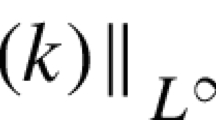Abstract
In recent years the theory of weak turbulence, i.e. the stochastic theory of nonlinear waves [I, 9], has been intensively developed. In the theory of weak turbulence nonlinearity of waves is assumed to be small; this enables us, using the hypothesis of the random nature of the phases of individual waves, to obtain the kinetic equation for the mean squares of the wave aplitudes.
In many cases of weak turbulence a situation arises where damping is considerable in the region of large wave numbers and is separated from the region where the basic energy of the waves is concentrated (as a result either of pumping or of the initial conditions) with a wide region of transparency. In [3,4] the hypothesis was stated that weak turbulence in these eases is completely analogous to hydrodynamic turbulence for large Reynolds numbers in the sense that in the region of transparency a univelsal spectrum is established which is determined onIy by the flow of energy into the region of large wave numbers. The spectrum of hydrodynamic turbulence Sk - k 5/s was obtained by A. N. Kolmogorov and A. M. Obukhov [5,6] from dimensional considerations. In the case of weak turbulence the spectrum - obtained as an exact solution of the stationary kinetic equation.
Below the ease of weak turbulence of capillary waves on the surface of a liquid is considered.
A kinetic equation is obtained for capillary waves. It is significant that in this case the basic contribution to interaction is provided by the process of the decomposition of a wave into two and by the process of two waves merging into one.
It is shown that the collision term of the kinetic equation vanishes with the solution ek - k 7/4. Arguments are advanced in favor of the fact that this solution can be interpreted as a universal spectrum in the region of transparency.
Similar content being viewed by others
References
B. B. Kadomtsev, “Turbulence of plasmas,” collection: Problems of the Theory of Plasmas [in Russian], Atomizdat, no. 4, p. 188, 1964.
A. A. Galeev, V. I. Karpman, and R. Z. Sagdeev, “Multiparticle aspects of the theory of turbulence of a plasma,” Nuclear Fusion, vol. 5, no. 1, p. 20, 1965.
V. E. Zakharov, “Weak turbulence in media with a decay spectrum,” PMTF [Journal of Applied Mechanics and Technical Physics], no. 4, p. 35, 1965.
V. E. Zakharov and N. N. Filonenko, “Energy spectrum of stochastic gravitational waves,” Dokl. AN SSSR, vol. 170, no. 6, p. 1292, 1966.
A. M. Kolmogorov, “The local structure of turbulence in an incompressible liquid for very large Reynolds numbers,” Dokl. AN SSSR, vol. 30, no. 4, p. 299, 1941.
A. M. Obukhov, “On energy distribution in the spectrum of a turbulent flow,” Izv. AN SSSR, Ser. geogr. i fiz., vol. 5, no. 4, 5, p. 453, 1941.
A. A. Vedenov, Introduction to the theory of a weakly turbulent plasma [in Russian], Atomizdat, no. 3, p. 203, 1963.
A. A. Galeev and V. I. Karpman, “A turbulent theory of a slightly unbalanced rarefied plasma,” Zh. eksperim. i teor. fiz., vol. 44, no. 2, p. 592, 1963.
L. D. Landau and E. M. Lifshits, Mechanics of Solids [in Russian], Gostekhizdat, 1953.
Author information
Authors and Affiliations
Rights and permissions
About this article
Cite this article
Zakharov, V.E., Filonenko, N.N. Weak turbulence of capillary waves. J Appl Mech Tech Phys 8, 37–40 (1967). https://doi.org/10.1007/BF00915178
Issue Date:
DOI: https://doi.org/10.1007/BF00915178




